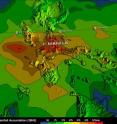NASA 3-D map shows flooding rains of Typhoon Ketsana in Philippines
The Tropical Rainfall Measuring Mission or TRMM satellite, orbits the Earth and measures the amount of rainfall created by a tropical cyclone. When Typhoon Ketsana (known in the Phillippines as "Ondoy") made landfall early this past weekend TRMM was monitoring its rainfall. That data was used to create a 3-D map of rainfall over the Philippines from September 21-28. According to the Philippine Atmospheric Geophysical Astronomical Services Administration (PAGASA), Ketsana dropped 17.9 inches (455 mm) of rain in Manila in just 24 hours on Saturday, September 26.
The TRMM-based, near-real time Multi-satellite Precipitation Analysis (TMPA) at the NASA Goddard Space Flight Center, Greenbelt, Md. is used to monitor rainfall over the global Tropics. TMPA rainfall totals for the 7-day period 21 to 28 September 2009 for the northern Philippines and the surrounding region showed that the highest rainfall totals occurred south of the storm's track in an east-west band over central Luzon that includes Manila. Amounts in this region are on the order of 375 mm (~15 inches) to over 475 mm (~19 inches). The highest recorded amount from the TMPA near Manila was 585.5 mm (almost 24 inches).
Ketsana maintained minimal tropical storm intensity as it crossed central Luzon on the afternoon of September 26 (local time). The main deluge in the Manila area, located on the western side of Luzon, began around 8:00 a.m. local time even though the center of Ketsana had yet to make landfall on the eastern side of the island.
A record 13.43 inches of rain fell in Manila in the six hours between 8 a.m. and 2 p.m. local time, which is equivalent to about a month's worth of rain for the area. The enhanced rainfall over on the Manila-side of the island as the storm approached was because of an interaction between Ketsana's circulation and the seasonal southwest monsoon.
Source: NASA/Goddard Space Flight Center
Articles on the same topic
- NASA's TRMM sees huge Typhoon Parma bringing more rain to the PhilippinesFri, 2 Oct 2009, 17:27:00 UTC
- Warnings up for Philippines as Parma powers up to a super typhoonFri, 2 Oct 2009, 2:35:40 UTC
- NASA's infrared satellite images reveal Ketsana's deadly western Pacific marchWed, 30 Sep 2009, 22:10:43 UTC
Other sources
- NASA's TRMM sees huge Typhoon Parma bringing more rain to the Philippinesfrom Science BlogFri, 2 Oct 2009, 20:28:10 UTC
- NASA's TRMM sees huge Typhoon Parma bringing more rain to the Philippinesfrom PhysorgFri, 2 Oct 2009, 18:49:16 UTC
- NASA's TRMM sees huge Typhoon Parma bringing more rain to the Philippinesfrom Science BlogFri, 2 Oct 2009, 18:14:19 UTC
- Warnings up for Philippines as Parma powers up to a super typhoonfrom PhysorgFri, 2 Oct 2009, 2:35:09 UTC
- NASA 3-D map shows flooding rains of Typhoon Ketsana in Philippinesfrom PhysorgThu, 1 Oct 2009, 22:28:09 UTC
- NASA's infrared satellite images reveal Ketsana's deadly western Pacific marchfrom Science BlogThu, 1 Oct 2009, 1:28:19 UTC
- NASA's infrared satellite images reveal Ketsana's deadly western Pacific marchfrom Science BlogWed, 30 Sep 2009, 22:07:23 UTC
- NASA's infrared satellite images reveal Ketsana's deadly western Pacific marchfrom PhysorgWed, 30 Sep 2009, 22:07:10 UTC
